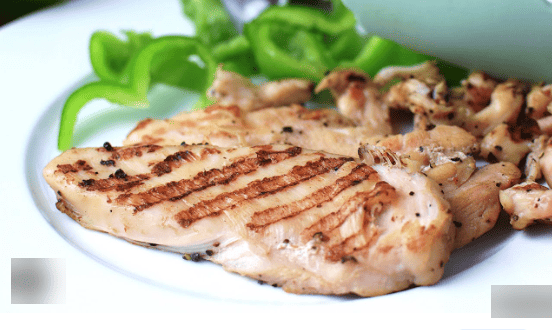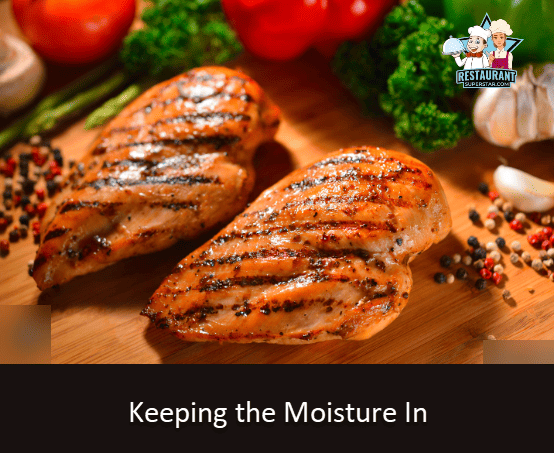How Do Restaurants Make Chicken Breast So Tender?

If you’ve ever wondered how restaurants achieve such tender chicken breast, you’re right on track. This article delves into that and other fascinating culinary inquiries that intrigue you.
How Do Restaurants Make Chicken Breast So Tender?
How Do Restaurants Make Chicken Breast So Tender? Restaurants employ a blend of marinating, velveting, and precise timing, among other techniques, to achieve that crave-worthy tenderness in chicken breast.
While we’ve just scratched the surface here, this article unfolds the secrets behind the tender chicken breast you relish at restaurants.
Whether you’re a budding restaurateur, an aspiring chef, or a DIY cooking fan, this is your gateway to unveiling the art and science of tenderizing chicken the restaurant way.
Welcome to the flavorful world of tender chicken breast, a staple in many restaurants’ menus.
I’m Jeff, your friendly restaurant consultant from the sunny state of Florida.
Over the years, I’ve been in the same boat as you, wondering how restaurants make chicken breasts so tender.
It’s a question that sent me on a culinary journey through the bustling kitchens of seasoned chefs to the quaint little eateries that Florida boasts.
Now, armed with savory secrets and a dash of Floridian charm, I’m here to unravel the tender mystery that makes restaurant chicken breast a league apart.
So, suppose you’re a new restaurant owner, a young chef ready to make your mark, or a home cook eager to bring restaurant-grade tenderness to your chicken dishes. In that case, you’re in for a tender treat.
Unlocking the Secrets to Tender Chicken Breast

Alright, let’s dive into the juicy realm of breasts. It’s a mix of art and science when it comes to unlocking the secrets behind that mouthwatering tenderness you find in restaurants. Here are some tried-and-true methods that never fail to hit the spot:
Marinating for Tenderness
Marinating is like prepping your chicken for a flavor-packed journey.
It’s about immersing those juicy breasts in a concoction of acidic ingredients like lemon juice or yogurt mingled with herbs and spices.
This not only tenderizes the chicken but embarks it on a flavor voyage, making each bite a destination.
Velveting: The Chinese Technique
Have you ever wondered how Chinese restaurants make their chicken almost melt-in-your-mouth tender?
This cooking technique, velveting, entails delicately coating the chicken in a blend of cornstarch and egg white.
The result is a protective armor that locks in the moisture. It safeguards it from the intense heat, resulting in a smooth, velvety texture.
The Magic of Brining
Brining is akin to giving your chicken a rejuvenating spa day. A soak in a saltwater solution seasons the meat and improves its texture, making it juicy and succulent.
The salt infiltrates the muscle fibers, creating small pockets of moisture that refuse to leave even when cooked.
Pounding to Perfection
Pounding the chicken might seem like a workout, but it’s a shortcut to tender perfection.
It evens the thickness, ensuring a uniform cook and breaking down those tough muscle fibers. Pounding is your ticket to a tender, juicy result, whether grilling or pan-searing.
These methods are your keys to unraveling the tender mystery of restaurant-style chicken breast.
Each technique is a step towards achieving that tender, juicy, and flavorful chicken that will have your patrons returning for more.
So, grab your marinade, your meat mallet, or your brine, and let’s tenderize.
The Taste Difference: Restaurant vs Home-Cooked:
When you compare restaurant-style chicken to home-cooked, the taste difference is undeniable.
Restaurant-style chicken is renowned for its mouthwatering tenderness and juiciness.
In contrast, home-cooked chicken often needs to catch up, tending to be dry or tough. This disparity arises from various factors, with professional chefs’ expert techniques playing a prominent role in crafting their delectable dishes.
Here are some essential techniques.
Fresh, Quality Ingredients
Now, this is a biggie. It’s like comparing freshly squeezed Florida orange juice to that store-bought carton. Restaurants, especially the good ones, make it a point to source fresh, in-season ingredients.
These ingredients are delivered daily, ensuring the chicken is top-notch in flavor and texture. Remember, the taste always starts from the source.
Homemade Sauces and Seasonings
Have you ever noticed how restaurant sauces have that ‘oomph’ factor? Most restaurants prepare sauces, condiments, and even stocks from scratch. It’s not just about tossing a few spices together.
It’s an art form – carefully measuring, simmering, tasting, and tweaking till it’s just right. Properly seasoned chicken and rich homemade sauces can elevate a dish from good to “Oh my, I need more of this!”
Now, a few more insights to sink your teeth into:
Tender Love & Care (TLC) Techniques
Restaurants use an array of techniques to treat the chicken right. From pounding for tenderness, marinating for flavor, to brining for juiciness, it’s all about that TLC.
And let’s remember the magic of cooking at the perfect temperature and time. It’s like a carefully choreographed dance to ensure the chicken is tender, moist, and flavorful.
Expertise Matters
Restaurants often have professional chefs behind the scenes. With their years of specialized training, these culinary wizards know their chicken inside out.
From the perfect cut to the ideal cooking method, their expertise ensures that the chicken always turns perfect.
Special Tools & Equipment
Now, while your home kitchen might have some nifty gadgets, restaurants often have access to specialized equipment.
Whether it’s a state-of-the-art grill or a high-precision sous-vide machine, these tools play a pivotal role in achieving that restaurant-grade taste.
And a tidbit for those who love diving deep: Sometimes, restaurants might brine their chicken with a hint of monosodium glutamate (MSG) for that extra punch of flavor.
And before it hits the grill, an excellent ol’ pounding ensures the chicken is as tender as can be.
Keeping the Moisture In Techniques for Moist, Juicy Chicken

The charm of a tender, juicy chicken breast lies in its moisture. One age-old secret from the restaurant world is velveting.
Picture coating the chicken in a mixture of cornstarch and egg white, maybe a splash of rice wine, creating a shield that locks in the moisture. This protective attire ensures the chicken remains tender amidst the fiery dance on the grill or wok.
On the other hand, bringing is like a rejuvenating soak in a saltwater bath, enhancing the chicken’s texture and flavor and keeping it moist from the first bite to the last.
A mindful avoidance of overcooking seals the deal on maintaining that coveted moistness.
Speedy Restaurant Cooking Techniques: Advanced Preparation

When you dine out, you all might’ve noticed that restaurant chicken feels on a whole other level of tenderness. That’s not just magic or some Florida sunshine mixed in; it’s about preparation and using the right tools. Here’s what the pros are doing behind those kitchen doors:
Marinating Game Strong
One of the first steps is marinating that chicken for at least 20-25 minutes. Sometimes even overnight.
Using ingredients like cornstarch, egg white, and vinegar adds flavor and tenderizes the meat. And trust me, this little tip is gold for that perfect, juicy chicken breast.
Cover and Cook
This might seem basic, but covering your chicken with a lid while cooking is an absolute game-changer. This method traps steam and moisture, which helps the chicken cook evenly and quickly. Perfect for when you have hungry mouths waiting!
It’s All About the Cut
Restaurants often debone the chicken or slice it into smaller pieces. This doesn’t just look fancy; it significantly cuts the cooking time. Smaller pieces mean the heat gets in there faster and more evenly.
Acid is Your Friend
Adding a touch of vinegar or any acidic liquid is like giving the chicken a spa treatment. This helps break down the protein structure, resulting in a tender and moist bite every time.
Pre-Heat Like a Pro
You need to preheat your oven or grill to a high temperature. Doing this ensures your chicken is cooked rapidly and reaches that safe, golden number of 165°F (or 74°C for our metric friends).
Commercial Equipment Wins
This might be out of reach for our DIY cooking enthusiasts, but it’s worth noting.
Restaurants use commercial equipment like heavy-duty deep fryers, massive flat-top grills, and power-packed ovens.
These bad boys aren’t just more significant in size and specifically designed to cook efficiently and quickly.
Keeping the Moisture In

Over the years, I’ve had many delicious, juicy chicken dishes at a backyard BBQ in Tampa or a fancy eatery in Orlando. And I’ve often wondered how they keep that chicken so darn moist.
After diving deep into the culinary world and rubbing shoulders with some of the finest chefs in Florida, I’ve got the low-down for you, especially for new restaurant owners and young chefs looking to up your chicken game.
Techniques for Moist, Juicy Chicken
Alright, let’s dive into the juicy details. Here are some techniques to make sure your chicken is finger-licking good every single time:
Velveting Is Magic
First off, let’s talk about this thing called ‘velveting.’ Now, if you’ve ever enjoyed a Chinese takeout and wondered why that chicken is so tender, here’s your answer. Velveting involves coating your chicken with cornstarch, egg white, and sometimes a rice wine or vinegar splash. This creates armor that locks in all that yumminess.
When you toss that chicken in a wok or grill, the heat doesn’t risk drying it out. The result? Chicken that’s so soft, it practically melts in your mouth.
The Brining Brilliance
Next up, let’s chat about bringing. This isn’t some fancy chef technique – it’s simple science and a bit of patience. Brining is like giving your chicken a luxurious saltwater bath.
The magic here is that the salt permeates the chicken, creating little pockets that trap water.
So, when you’re cooking, all that moisture has nowhere to go but stays right in the meat, ensuring every bite is juicy and flavorful.
Simple Yet Crucial – Don’t Overdo It!
Here’s my golden nugget of advice: avoid overcooking that chicken like you’d avoid an alligator in your swimming pool! Overcooked chicken is dry and challenging, and no amount of fancy techniques can save it. Remember, each chicken piece has its perfect cooking time. Respect that, and you’re golden.
There you have it, folks. So, remember these techniques whether you’re starting a new restaurant, mastering the art of cooking, or just trying to impress with a DIY dinner.
It’s all about locking in that moisture and treating your chicken right. Happy cooking and enjoying those tender, juicy chicken dishes from the sunny shores of Florida.
How Do restaurants get Chicken so thin?

One of the biggest secrets behind perfectly tender chicken dishes is thin slicing. Many restaurants can access commercial-grade equipment, like a meat slicer or deli cutter.
But if you don’t have those tools, don’t worry.
You can still get that restaurant-quality chicken with a sharp knife and some practice. Here are my tips for thin-slicing chicken:
Achieving the Thin, Tender Cut
Now, there’s an art and science to getting that chicken thin yet juicy, and it isn’t just about putting it on a diet.
Here’s what goes down:
- The Almighty Pound: This isn’t about money, but it is about value. Restaurants often use a meat mallet (which looks like a hammer) or sometimes even a rolling pin to pound the chicken. Imagine this: take that chicken and gently place it between two sheets of waxed paper or in a resealable plastic bag. Then, carefully pound the chicken with light and deliberate strikes, starting from the center and working outwards. What this does is not just make it thin but also break down those muscle fibers. The result? An even thickness, faster cooking time, and a piece of chicken that’s as juicy as a summer watermelon!
- Precision Slicing: Now, here’s a neat trick. If you’ve ever tried slicing a completely thawed chicken breast, you’ll know it’s slippery. But when the chicken is partially frozen? That’s a game-changer. Restaurants often slice the chicken when it’s in this state. This makes making those thin, precise cuts easier, going against the grain. The benefit? Less toughness and a better, silkier texture in every bite.
And that’s all there is to it! So next time you cook chicken at home or savor it at your go-to diner, you’ll know all about that skinny chicken. These little details can take a dish from okay to “I want seconds!”
From one chicken lover to another, keep those culinary adventures going. And hey, thin doesn’t mean it lacks flavor; in the fantastic world of chicken, it often means much more.
Frequently ASKED Questions
How Do Restaurants Tenderise Chicken?
Restaurants often tenderize chicken using a method known as Velveting Chicken with baking soda. This technique, popular in many Chinese restaurants, makes the chicken incredibly tender. It’s a straightforward method that is also applicable to beef.
How to Make Chicken Super Tender?
To achieve highly tender chicken, it’s best to simmer it gently. Use water as the cooking liquid, rapidly absorbing flavors from onion, garlic, and chicken. Add enough water to cover the chicken, bring it to a low simmer, and let it cook for about 30 minutes until it becomes very tender.
How to Cook Chicken Breasts Where They Aren’t Dry and Tough?
To cook juicy and tender chicken breasts, arrange them in a single layer in a pan. Add a liquid like water or broth and seasonings like salt, spices, herbs, or soy sauce. Heat the liquid until it boils gently; then lower the heat and simmer.
Why Is Chicken from Chinese Restaurants So Tender?
Chinese restaurants often employ a unique technique known as velveting. Instead of stir-frying the meat and browning it, they use this method, resulting in soft and silky textured meat.
Why Does Restaurant Chicken Taste Better?
Several reasons contribute to the enhanced taste of restaurant chicken. The chicken is often brined with water and salt, increasing its flavor and moisture. The brine can also contain additional seasonings, including MSG. Additionally, restaurants might pound the chicken before grilling, making it even more tender.
Is Velveting Chicken Unhealthy?
Velveting chicken is a healthy preparation technique. The primary components, cornstarch and oil, are safe for consumption. Thus, velveting offers a way to enjoy tender and flavorful meat without compromising taste or health.
Conclusion:
Now that the tender secrets are placed on your table, it’s your turn to bring the captivating restaurant magic into your kitchen.
Whether you’re a young chef, a passionate and aspiring restaurateur, or a home-cooking hero, these exceptional techniques are vital to unlocking the ultimate succulence of a delectable chicken breast.
So, grab your favorite apron, expertly marinate with delectable flavors, tenderly brine to infuse a burst of juiciness, skillfully velvet for an unparalleled tenderness, or passionately pound with precision to achieve a delightful texture.
Your culinary journey, filled with remarkable moments, awaits as you embark on mastering the art of preparing a tender and juicy chicken breast, just like the renowned restaurants.
Remember, the secret to transforming your cooking skills is only a stove away. Are you prepared to embark on this captivating and tenderizing adventure?
Jeff Smith is a Restaurant Consultant with over 20 years of hospitality experience ranging from server to owner and general manager. He focuses on Restaurant POS technology as well as restaurant marketing. Check out our world-famous restaurant resources page for a comprehensive offering of hand-picked resources and tools to help your business. You can also check out some of our other restaurant business articles.


